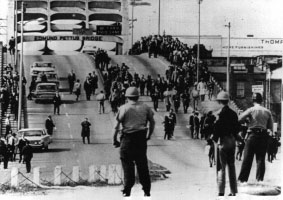Good Trouble
July 30, 2020 |
The horse-drawn hearse carried the body of John Lewis across the Edmund Pettus Bridge on Sunday. It was not Lewis’s first time at that place.The occasion offered a powerful reminder of what Lewis and others contributed to racial justice in this country--and also of how much more remains for us to accomplish.
Nearly four years ago, a series of racial bias incidents roiled our campus. In response, brave Black student leaders schooled me and many others on the quotidian racism experienced by our students and colleagues of color. (Others in our community had learned the same lessons long before; anti-racism is not new to them.)
Our students then issued us a challenge. When they needed us to listen four years ago, they found too few of us prepared to talk with them about race and racism.
Since then many of you have worked to answer their challenge—and my expectation—that each of us learn how to have a conversation about race with our students. You took intentional steps, individually and together, in formal and informal groups.
What steps? More than half of the college’s full-time faculty participated in the Diversity & Inclusion Teaching Academy and numerous other workshops and events related to diversity and teaching, for example. We learned together.
We listened to our experts. Recommendations from the new CAS Diversity & Inclusion Committee now inform most college policies and priorities: for example, contributions to the university’s strategic plan for diversity and inclusion are now a standard part of annual faculty evaluations; every academic program’s five-year plan includes diversity goals and strategies; and the new Hiring Guide for Faculty and Hiring for Diversity workshops have helped us recruit increasingly diverse cohorts of faculty—new colleagues whom we now invite to walk with us.
We have taken good, first steps in the past four years. Many more remain.
Some of the next steps have been mapped already. Earlier this month, Faculty Assembly issued a Commitment to Fight against Racism, Anti-Black Racism, and White Supremacy that lays out both principles and specific commitments. I am confident that our new and returning students will soon identify additional steps for us to take.
Many resources--including the new Racial Healing Grants (see below)--will support us on our way.
The path ahead will nevertheless be hard. We will not always agree. All the more, we will need to support one another, embracing the creative tensions at the heart of our Jesuit, Catholic mission, and drawing upon of our college's mutual commitments: Take risks. Be brave. And all the rest of them.
Consider the admonition John Lewis left us, in words delivered a few months ago on that same bridge in Alabama: “Get in good trouble, necessary trouble, and help redeem the soul of America.”
May John Lewis rest in well-deserved peace.
The rest of us? We still have work to do.
